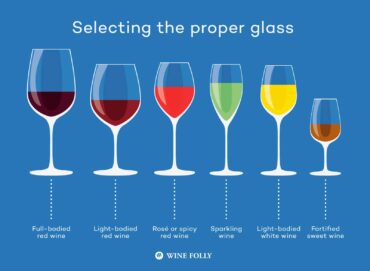
When cracking open a bottle of wine, most people reach for the nearest vessel resembling something that could remotely be used for properly drinking wine. But did you know that the flavor and enjoyment of wine can be largely affected by which kind of glass you’re drinking from?
Put down that mason jar and follow these tips to get more from your merlot.
Many things can affect the taste of wine — the glass shape, the temperatures at which the wine has been stored and then served, and the food you may be eating with the wine, not to mention the company you’re sharing that bottle with.
If you just want to drink and not experience the wine, you can choose any glass you like. If you want to experience wine to the fullest, select a glass that is made for that wine.

Over the last century, glasses have been designed for just about every major grape variety. Each wine style has specific characters in terms of acidity, fruit expression, tannin and alcohol, and the different glass shapes intensify or mellow those attributes.
If you really want to get serious about it, you can purchase a specific glass for each type of wine. A simpler idea is to just purchase a few of the basic-shaped glasses and choose one to match each wine you’re going to pour.
Generally, if you’re pouring a white wine, choose a glass with a smaller bowl, which will preserve the floral aromas, maintain cooler temperature and deliver more aromas, even at cooler temperatures, due to the proximity to the nose. Red wines are typically served in larger-bowled glasses to deliver more aroma compounds rather than the burn of ethanol from being farther from the nose. With a larger surface area to let ethanol evaporate and a wider opening, the wine taste smoother.

It’s hard to swirl that glass of big, bold red wine that is screaming to let off some amazing aromas when it’s trapped in a tiny glass. Larger bowls allow more oxygen to come in contact with the wine to help it open up, which is ideal for red wines. If you’ve ever heard someone say to open a bottle of wine and “let it breathe,” this is what they’re talking about.
Here are the basics of glass selection based on wine type.
Chardonnay/Viognier
This is the traditional white wine glass. It’s meant for young, fresh wines, as the slightly narrow rim concentrates the nose of highly aromatic white wines. The smaller bowl size also keeps white wine colder than the large bowls used for reds.
White Burgundy
White Burgundy is chardonnay grown in the Burgundy region in France. A glass for this wine looks similar in shape to a pinot noir glass but smaller in scale. The wide bowl and narrow rim concentrate aromas and achieve maximum aeration on creamy white wines to reveal subtle complexities and offset rich fruit concentration.
Cabernet Sauvignon/Bordeaux
This is your traditional red wine glass. Cabs and Bordeaux tend to be high in alcohol and tannin. A larger bowl with more height creates more distance between the wine and the drinker, causing ethanol to dissipate on the nose and allowing more oxygen to encourage tannins to soften.
Syrah/Shiraz
Slightly taller than the cabernet glass and with a slight taper at the top, this glass is designed to focus the fruit and allow plenty of aeration to mellow tannins in these massive red wines.
Pinot Noir/Burgundy
The extremely wide bowl and tapered rim allow plenty of aeration, concentrate delicate aromas and showcase the bright and rich fruit.
Sparkling
There is a glass made for almost every kind of sparkling wine under the sun. You can go overboard with which one you’ll choose if you’re serious about bubbles — or just select a basic Champagne flute that keeps the fruit and potential yeasty aromas focused with its narrow design, but also allows the effervescence to remain fresh and flow longer.
In recent years, glass producers have developed a sparkling wine glass that is a bit less narrow at the base. Think white wine glass meets Champagne flute. The thought behind this newer glass is that the skinny flute presents Champagne as one-dimensional, because you can’t get your nose into the glass to get the full wine experience. It also concentrates the bubbles and in trying to get the aromas, you’ll often get a nose full of fizz and acidity instead.
The wider, tulip- or egg-shaped flute allows for a wine lover to appreciate the full range of aromas. This is still a beautiful, stylish glass and lets you take in the full appreciation of the wine.
Fortified Wine
These wines are higher in alcohol and need a smaller bowl to reduce alcohol evaporation and highlight the rich fruit and complex aromas.
To Stem or Not to Stem?
In order to maintain the temperature in a glass of wine, you’ll want to be able to hold onto the stem. You can’t do that if you’re using a stemless glass. It’s not as big of a deal for red wines but can dramatically change the temperature of the white wines and will warm them up too quickly, affecting the flavor if you don’t have a stem to hold onto.
Plus, who wants to look at fingerprints all over their glass? To properly hold a wine glass, grab the stem by the base of the glass and hold it between your thumb and forefinger.
Rim Thickness
Another element to enjoying a proper glass of wine is the thickness of the glass rim. If you’re drinking out of a thicker-rimmed glass, you’re getting more glass experience in your mouth than you should.
To really enjoy as much of the wine as possible, choose a glass with a superthin rim (be careful of breakage on those thinner glasses). The glass should fade into the background and not feel heavy, clunky or thick.
Try to experiment with different glass types. Pour a glass of your favorite wine in a water glass. Swirl, sniff and taste the wine. Now, pour a glass of that same wine into a proper wine glass and follow those same tasting basics of swirling, sniffing and tasting to see the difference.





























